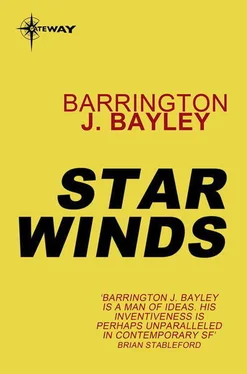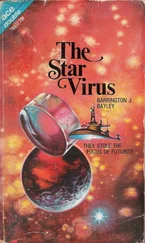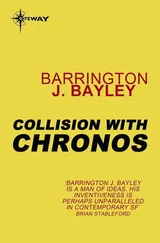While Rachad pondered this, Amschel rose to his feet. “These operations I have described—reduction to prima materia , and then fashioning this into the Stone—are difficult in the extreme. Let me show you how I have attempted to achieve them.”
He led the way to a section of the vaults Rachad had not visited previously. He lifted the latch of a massive door, made not of adamant but of timber, and pushed it open.
The space within was dominated by cucurbits and retorts of unfamiliar shapes and sizes. Most striking were those that were spherical. These were enormous, the largest of them a monstrous piece of glassware ten feet in diameter. Many of the vessels contained complicated structures of metal, finely wrought into sheets and wires, and their sealed delivery spouts—some cucurbits had as many as half a dozen—were connected not to glass pipes but to infusoratory cables which snaked across the floor.
Two white-smocked assistants bowed as the master alchemist entered. Rachad quickly realized that this was a special laboratory devoted to the use of infusoration. The smell of galvanism was in the air, plus an unmistakable sense of tension which was added to by angry buzzing noises leaking from the metal conductors.
His eye was caught by a bulbous, fairly small cucurbit that seemed to be inwardly alive. It flashed, writhed and bubbled with frenzied light which washed against its walls in waves.
“The mercuric compound within this vessel has experienced a continuous discharge of infusoration for the past three years,” Amschel supplied, noticing his interest. “Shortly I will end the experiment and see what change has come about.”
“Where are the actual infusorators?” Rachad asked. “I see none.”
“They are very bulky, and are kept in adjoining chambers,” Amschel said. With a wave of his hand he indicated all the apparatus by which they were surrounded. “To understand what I have been doing here, you must recall the ages-old belief that the Great Work can be accomplished if only sufficient heat can be generated. To try to develop an unnaturally high temperature is one reason why alchemists heat the subject for long periods in an hermetically sealed crystal egg. For many years I, too, concentrated on trying to obtain more and more heat by means of fire. I worked with a man who believed he had found the answer in a heavy metal called the second lead —though the ancients named it after one of their gods, Uranus. This metal hides great quantities of fire in itself, which can be concentrated and extracted if it is refined in a certain way.”
Amschel’s voice fell. “The experiment was disastrous. The temperatures obtained were enormous, but the fire of the second lead is no ordinary fire. It proved so penetrating and dangerous that it overcame the metal itself and came bubbling out of the pit we had prepared for it. I was the only survivor, and even I have suffered ever since from a weakness of the blood.”
He paused before continuing. “Eventually I concluded that fire alone will never be sufficient. I decided to switch my attention to etheric heat , using infusoration to create tenuous, rarefied forms of air and fire known as plasmas. To make a plasma, the vessel is first emptied of atmospheric air, and the subject to be transformed is then injected and infusoration is applied in immense quantities. Temperatures so obtained can rival those in the center of a star.
“That, at least, is the bare principle. In practice, life-times could be spent researching plasmas. Note one of our first efforts.”
Amschel directed Rachad’s attention to possibly the weirdest device in the laboratory: a large glass tube in the form of a six-foot ring, collared at intervals with thick coils of wire. “Meet our Ouroborous—our attempt to construct the Great Worm in physical form.”
Amschel pulled down a lever. The air crackled and snapped. A hazy ribbon of light sprang into being throughout the length of the circular tube, pulsing along the center of the channel. Brighter and brighter it grew, and for a second seemed stable. But suddenly it writhed, jerked, and abruptly vanished, leaving black scorch marks on the inside of the glass.
“Try as we might, we could never get it to maintain itself,” Amschel said. “Not for nothing is the Worm described as the Impossible Stability.”
The alchemist moved to the great cucurbit that occupied the center of the chamber: globular, ten feet in diameter, plates and coils arrayed within its walls. “Later, however, we were more successful,” he said. “I have been able to confirm that infusoration, if intense enough, can produce such torsions and tensions as to bring matter close to the threshold to prima materia , though we have not, as yet, produced complete breakdown. We will demonstrate.”
He gestured to his assistants, issuing clipped orders. The helpers dragged heavy cables across the floor, clipping them into big junction boxes.
Finally everyone stood back as power was applied through five different delivery spouts. The very air Rachad breathed seemed to sizzle; sparks flew from the junction boxes. He became aware of a hum that seemed to set his eardrums shaking just below the level of audibility.
Inside the cucurbit, the metal plates glowed fiercely. A spot of light appeared in the center of the globe, expanding, writhing, then coalescing into definite form.
Rachad gaped at what he saw. Hovering in the globe was the shape of a man, draped in a purple robe, staring toward them through the thick glass.
As quickly as it had come, the vision vanished, to be succeeded by an inhuman, brass-colored figure mounted on a horse-like beast that apparently was galloping onward. Then it, too, was replaced—by a gorgeous flowering orchid as tall as a man.
Faster and faster the phantoms came: people, animals, plants. Amschel, aware of Rachad’s bewilderment, leaned close to him.
“These creatures are not mere apparitions: they are real, though transient. The field of stress causes them to stream spontaneously out of the threshold to prima materia .”
Suddenly there was a deafening bang . One of the cables had parted at a solder joint, spitting out a shower of sparks. In the cucurbit, the visions died.
“But this is magic!” Rachad exclaimed.
“Not magic, but art. Thus was the world created; thus did all things proceed from the One. Hyle contains all forms in potential.”
Amschel moved across the chamber and opened one of his ubiquitous sample cases. Returning, he showed Rachad a number of small objects he held in the palm of his hand: honey-colored pills about half an inch in diameter.
“Although the creatures that stream from the threshold are momentary only, there is a way to trap and fix the life-denoting virtue within the field. These seeds, if placed in water in which certain mineral salts are dissolved, will bring living forms to fruition.”
“Homunculi,” Rachad breathed.
“Yes, homunculi. The minor goal of the alchemist’s art.”
“It still seems like magic to me,” Rachad said.
“But think: is not nature’s work also alchemy? Every planet is a cucurbit, in which chemicals are mixed. Every sun is an athanor, which heats planets; and so life arises. By compressing the work of eons into a small span of time, the hermetic art is achieved.”
“But the Philosopher’s Stone doesn’t occur naturally at all.”
“No,” Amschel said. “The Stone is solely the work of man.”
Dressed all in purple and black stripe and wearing his insignia of rank, Baron Matello was waiting in the courtyard of his castle when King Lutheron’s golden coach came clattering through the gate, its windows shrouded. The carriage came to rest; a footman hastened down from the rear to open the door, with its elaborate coat of arms.
Читать дальше












